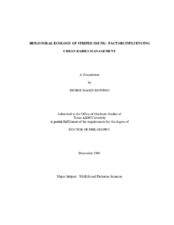| dc.description.abstract | Striped skunks (Mephitis mephitis) are a rabies vector in Texas and efforts are
underway to develop an oral rabies vaccination program for skunks. To better
understand some of the components necessary, I studied the habitat preferences and
home range of skunks, an alternative skunk capture method, and surveyed the
knowledge base of medical providers practicing across the state. I radiocollared 99
skunks from the Houston, Texas metropolitan area and monitored skunk movements
from March 2004–June 2006. To accelerate progress of this study, I captured 93 of 99
skunks using a dip net. Dip netting allowed for an effective collection alternative to
cage trapping. Movement data indicated a strong preference for short grass areas (82%),
however, habitat use changed to remote, brushy areas when temperatures were ≤7C.
Habitat use during the year was different (P = 0.001), with December 2004, January
2005, and February 2005 significantly (P = 0.001) different from one another.
Additionally, habitat use during December 2005, February 2006, and March 2006 were
significantly different (P = 0.045, P =0.098, and P =0.003, respectively). Data from 20 skunks, covering multiple seasons, were analyzed for home range use. I found male
home range use averaged 255 ha (217–345), while females averaged 126 ha (60–218).
Male range use was significantly larger than females (P = 0.005). No significant
seasonal movements were observed. Lastly, I conducted a survey of 297 Texas primary
care medical providers to assess their knowledge of rabies vaccine procedures and their
experience with rabies vaccines. Small town providers within the oral rabies vaccination
baiting zone were more aware of rabies prophylaxis (P < 0.03), however, most providers
(>95% of 297) rarely saw patients for rabies prophylaxis. Survey data indicated
providers have minimal, if any, experience with acquiring and administering rabies
prophylaxis. My data suggests that an effective oral rabies vaccination program could
be established within urban areas by using short grass area baiting strategies during the
fall season, using dip net capturing for faster surveillance collection, and by initiating a
rabies education program targeted at Texas’ primary care physicians and their staff. | en |


